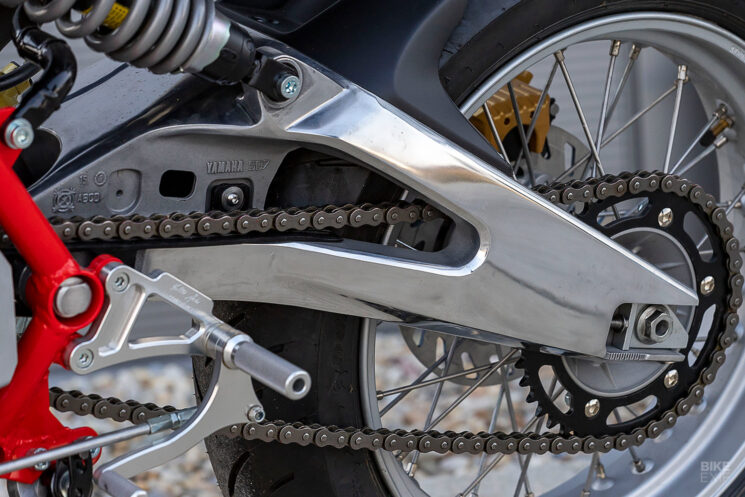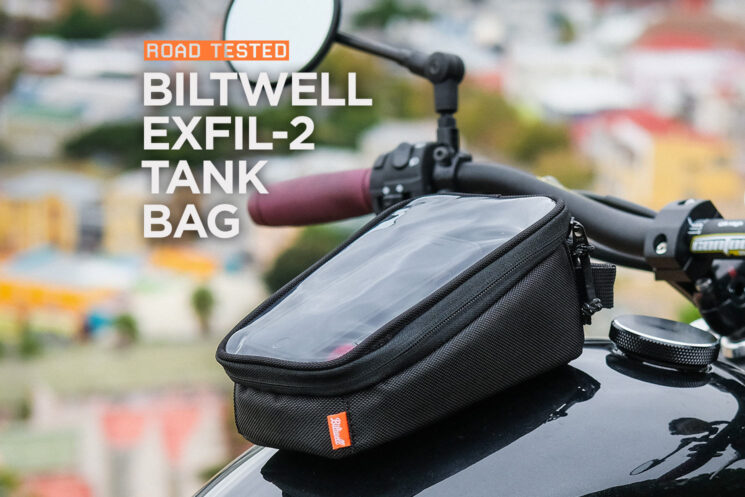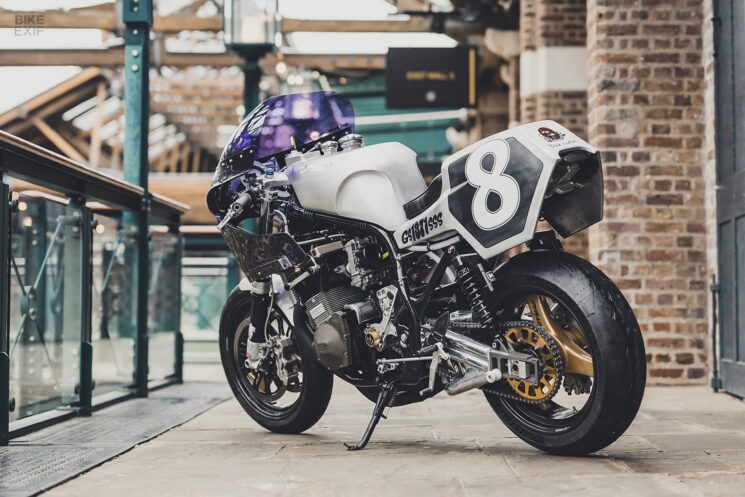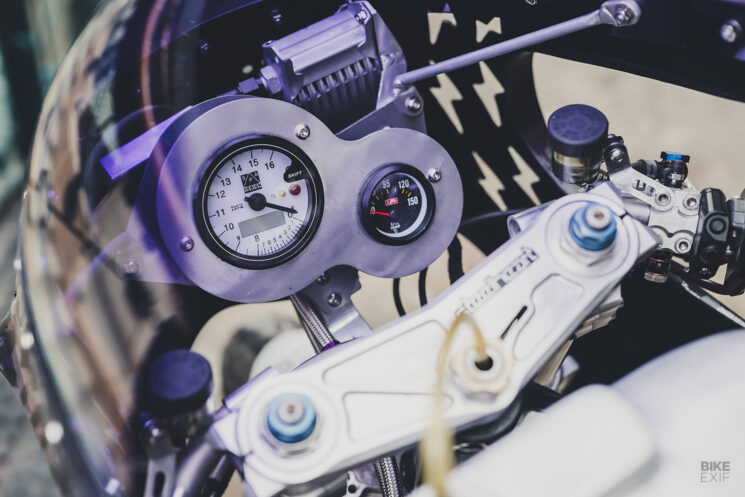
VTR Customs leads the charge this week, with an aggressive take on the gigantic BMW R18. We also look at a couple of kits for the retro-fantastic Yamaha XSR900 GP, the special edition Triumph Trident Triple Tribute, and a spunky Kawasaki ZXR400 SP that’s currently on auction.

BMW R18 by VTR Customs VTR is at it again. The Swiss BMW specialist workshop has a knack for transforming brand-new BMWs into mad neo-retro customs. This time, they’ve worked their particular brand of magic on the monstrous BMW R18 cruiser.
Dubbed ‘TRACK8716,’ VTR Customs’ R18 takes the classic drag-cruiser vibe and cranks it up to eleven. The team retained the bike’s OEM fuel tank but ditched the rest of the bodywork. The R18 now wears handcrafted aluminum front and rear fenders, and a handmade aluminum headlight nacelle that pulls inspiration from vintage aircraft designs.

A slim bobber-style seat from FCR Original in France wears lush upholstery, executed by regular VTR collaborator Yves Knobel. Freuler AG handled the paint; a modern BMW grey with M-series-style color highlights.
This R18 is more than just a pretty face though. It’s gone on a diet, courtesy of new 17” carbon fiber wheels from Rotobox. They’re wrapped in sticky Michelin sports tires.

There’s a height-adjustable Öhlins shock tucked in at the back, with a ceramic-coated (and heat-wrapped) Zard exhaust system handling the soundtrack. Other bolt-on bits include FCR Original foot pegs, ABM handlebars, and Kellerman LED turn signals and taillights.
VTR finished the bike off by blacking out most of its hard parts and coating the engine in a gutsy wrinkle-black finish. Custom tank badges add one last stylish detail. [VTR Customs]

Yamaha XSR900 GP replica kits In just a few weeks, we’ll be swinging a leg over the brand-new Yamaha XSR900 GP to find out if it rides as good as it looks. Yamaha’s neo-retro sportbike is arguably one of the most attractive production bikes currently in circulation, taking inspiration from Yamaha’s legendary YZR500 Grand Prix racer.
Y’s Gear—a major accessories manufacturer and a subsidiary of Yamaha—has just released two new graphics kits that add even more retro appeal to the already alluring XSR900 GP. Debuting at the Osaka Motorcycle Show in Japan earlier this month, they pay homage to two more historic Yamaha models.
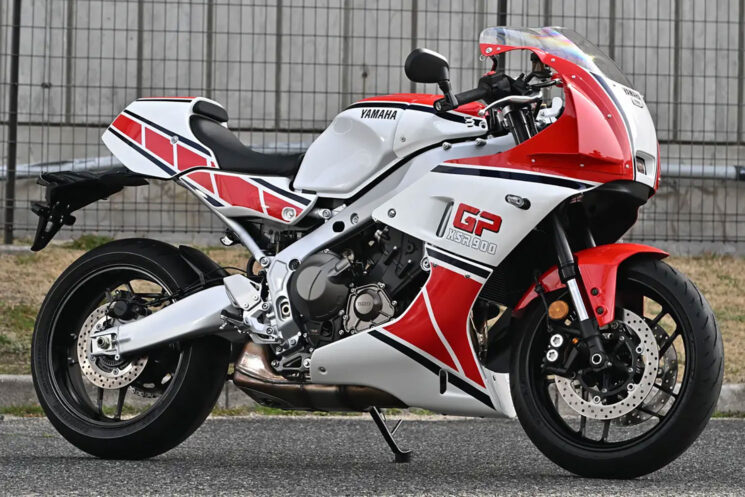
The predominantly red bike [above] is a nod to the 1984 Yamaha RZV500R, carrying over the RZV’s distinctive tapered ‘speed blocks’ design and dark blue striping. The other bike [below] trades the red on the upper bits for more dark blue, making it a clear tribute to the 1984 Yamaha FZ400R.
As far as we can tell, Y’s Gear plans to offer the RZV500R and FZ400R tribute designs as full bodywork kits. Each kit uses OEM XSR900 GP body panels, with the addition of Yamaha’s optional lower fairing. So transforming a stock XSR900 GP into one of these retro-fabulous machines should take no more than an afternoon.

The two bikes on show here feature a handful of further tweaks. The slim LED turn signals and tidy bar-end mirrors are all standard-issue Yamaha parts. Both bikes have been liberated of their foot pegs, and the FZ400R replica also gets a tinted screen, an Akrapovič can, and a tail tidy.
Sure, these two bikes are mild reskins rather than full-bore custom bikes—but they’re damn pretty, and they prove the XSR900 GP’s visual versatility. Now if someone wants to build a replica of King Kenny’s OW48 factory race bike, we’d be totally okay with that. [Source]
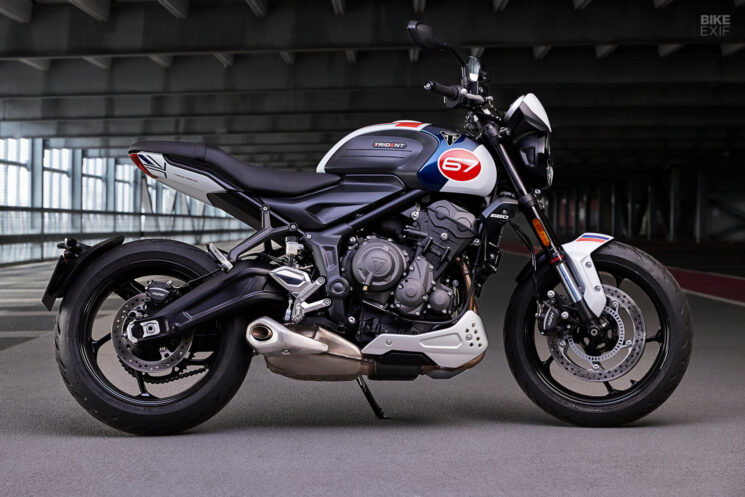
Triumph Trident Triple Tribute special edition Joining a long line of special edition bikes that are really just regular edition bikes with special liveries, the new Triumph Trident Triple Tribute pays tribute to one of Triumph’s most famous triples, ‘Slippery Sam.’
Slippery Sam was a race-prepped Triumph Trident 750 that earned its nickname at the 1970 Bol d’Or in France, where it spewed oil all over its two riders. It did manage a fifth-place finish though—and went on to win five consecutive production 750 cc class TT trophies at the Isle of Man, between 71 and 75. It was quite a looker too, sporting a white fairing with generous red and dark blue stripes.

The Triumph Trident Triple Tribute special edition apes Slippery Sam’s livery, wearing a white base coat with red and dark blue stripes, redesigned to complement the modern Trident’s lines. The ’67’ on each side of the fuel tank is a nod to Slippery Sam’s original race number.
With less real estate than the 1970s Trident, this classic color scheme doesn’t quite hit the right nostalgic notes. But it’s still a tidy look for a modern bike that also happens to be a total blast to ride. Although not as zesty as the Street Triple 765 RS, the Trident’s triple-cylinder mill still packs an 80-horsepower punch, in a flickable package that weighs just 189 kilos [417 pounds].

Triumph is only selling this edition of the Trident for one year—but the real kicker is the price. Curiously, the Triumph Trident Triple Tribute is priced from £7,895.00 in the UK, which is the same price as the base model Trident. Except that this special edition also comes with a belly pan, color-matched fly screen, and quick-shifter.
Love it or hate it, it’s refreshing to see a major manufacturer release a special edition that’s simply a subtle nod to the past, rather than a shameless cash grab. [More]
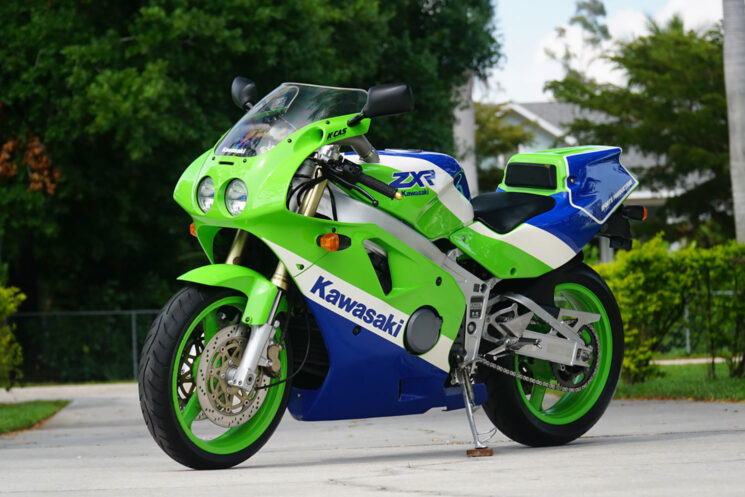
For sale: 1989 Kawasaki ZXR400 SP There’s something enticing about the 400 cc sportbikes that dominated the Japanese market in the late 80s and early 90s—and the 1989 Kawasaki ZXR400 SP epitomizes the mystique of the era.
Also known as the ZXR400 J1, the SP (‘Sports Production’) model was basically a homologation special. Styled like a miniature Kawasaki ZXR750—right down to the green wheels and hosepipe air ducts—the SP had a bunch of extra goodies that the base model XSR400 lacked.

Upgrades included a close ratio transmission, adjustable suspension, a lighter subframe, a single-seat tail section, and more. Its 398 cc four-cylinder mill redlined at 14,500 rpm and kicked out 60-ish horsepower, with a top speed of around 150 mph.
Pundits praised it for its performance and handling, with Visordown noting; “It not only looks superb, it delivers just what you expect a Kawasaki race replica to—namely a screaming engine with bags of power, a stiff chassis with decent suspension and a completely bonkers riding experience. All wrapped up in a bike that looks identical to the one that first brought a world superbike replica to the masses.”

This particular Kawasaki ZXR400 SP is currently up for sale over at Iconic Motorbike Auctions. It’s fully stock and in good nick, with the exact amount of wear and tear that you’d expect from a 35-year-old motorcycle. Showing a mere 9,532 km [5,922 miles] on the clock, it’s just had a service, too.
We’re tempted to put in an offer—just so that we can fire it up every morning and listen to it purr.
from Bike EXIF https://ift.tt/kt4BpGs












